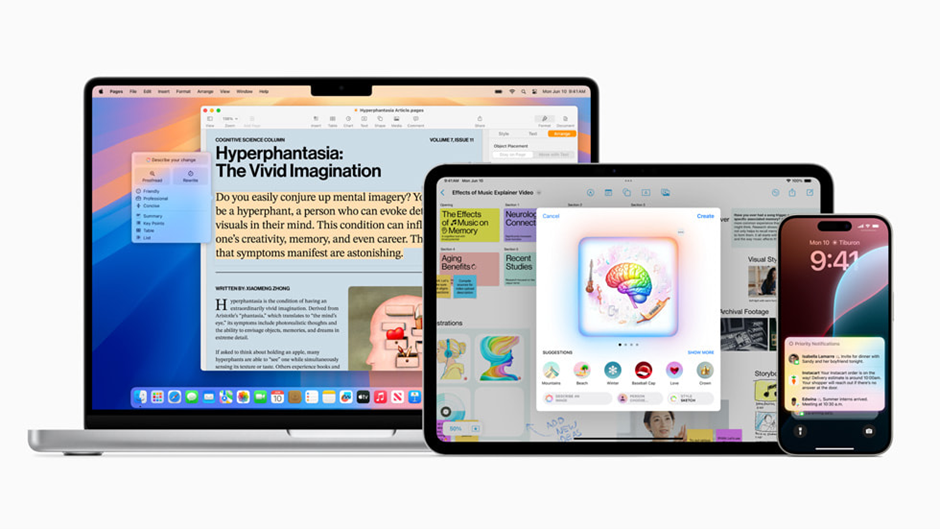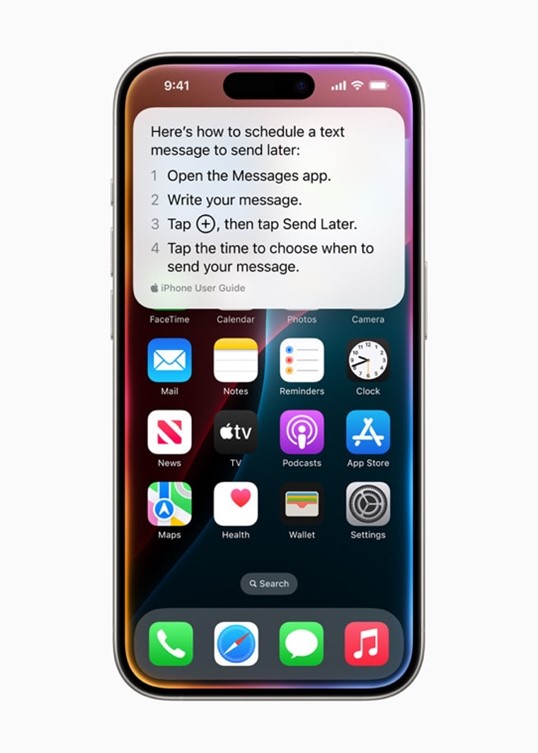At WWDC 2024, Apple introduced Apple Intelligence, a suite of AI applications for iOS 18, iPadOS 18, and macOS Sequoia, optimized for devices with A17 Pro and M1 or newer processors. Combining on-device AI with Private Cloud Compute, Apple ensures both powerful performance and data privacy. Key features include advanced writing tools, enhanced mail and messaging functions, generative image creation, and improved photo editing capabilities. Siri has been significantly updated, integrating ChatGPT to offer more accurate and helpful responses. Apple Intelligence leverages the powerful NPUs in the latest chips, while using secure cloud computing for more demanding tasks. The service will be free and available this fall in beta for compatible devices.

What do we think? We’ve had AMD’s, Google’s, Intel’s, Microsoft’s, MediaTek’s, Nvidia’s, and Qualcomm’s tech announcements and conferences, and now it’s Apple’s turn with its worldwide developers conference—WWDC. And, as you might have expected, WWDC was all about AI.
Last year, Apple’s big thing was the Vision Pro, which left us impressed but not awed or inspired—a very sophisticated and expensive science project. We doubt we’ll hear much about it again for a while. Now, it’s all about Apple Intelligence.
Once again, Apple has taken a group of features that, individually, are matched by offerings from Adobe, Microsoft, OpenAI, and others, and presented them in a format that should be seen as a master class in how to sell an AI PC.
Unlike everyone else, Apple didn’t need to harp on NPU TOPS. Their walled garden means minimal competition about what runs or what doesn’t. (Intel would no doubt love to be in the same position today.) Apple Intelligence will run on devices across a range of 11–38 TOPS of NPU performance.
The Private Cloud Compute angle is smart too, and leverages decades of Apple proving its privacy chops. With AI, privacy matters intensely, and Apple has a credible story.
The use of ChatGPT as a back end to a new Siri is pragmatic, letting Apple catch up quickly to the state of the art. No doubt, the OpenAI team is already looking forward to a future where Apple designs them out.
What’s missing? For a start, information about how the data requirements of all these features will affect memory and storage use.
Generative models + personal context = Apple Intelligence
Today, for the WWDC 2024 developers conference, Apple launched a range of AI applications that will run across iOS 18, iPadOS 18, and the new macOS, Sequoia, in devices with A17 Pro and M1 or later processors. As well as local AI, Apple will deliver Private Cloud Compute, scaling computational capacity between on-device processing and larger, server-based models that run on dedicated Apple silicon servers.
“Our unique approach,” said Apple CEO Tim Cook while announcing generative AI plus personalization features that are largely already announced from other vendors such as Microsoft and OpenAI. What is perhaps unique about Apple’s approach is the level of trust its users have in Apple solutions.
The solutions are grouped: Writing Tools use AI to help craft anything textual, and to transcribe and summarize audio; Mail gets retrieval and prioritization tools that share commonalities with new Notification and Messaging features; Image Playground creates generative images from use in documents, messaging, and social media (which get generative emojis); and Photos now come with natural language search, enabling better movie and slideshow creation, and extensive AI editing features.
Most important of all are the changes to Siri. Apple reminded us that Siri was the first personal assistant. It did not mention how largely superseded Siri has become in every important metric. But now, throwing down a gauntlet that Amazon and Google will have to respond to, Siri has been reinvented. We don’t say that lightly—we don’t expect much of old Siri to survive beyond the name. This new version of Siri can leverage ChatGPT as well as Apple Intelligence. A new glowing screen edge indicates when Siri is present.
Siri acts as a help bot, surfacing features and instructions in response to natural language help requests. On-screen awareness means Siri can pull information from anything displayed—for example, finding email addresses or appointments that you didn’t add to your calendar. Siri can also search and launch other apps, like Photos, Music, and Books.
Apple gave the example whereby a user can say, “Play that podcast that Jamie recommended,” and Siri will locate and play the episode, without the user having to remember whether it was mentioned in a text or an email.”

Apple stressed the importance of on-device processing for privacy and data sovereignty, and presumably Apple Intelligence requires a highly capable NPU. The A17 Pro delivers around 35 TOPS of NPU processing, and the M4, 38 TOPS. However, M1 is down at 11 TOPS (comparable to Intel Meteor Lake, which will not run Microsoft’s Copilot+, the PC competitor to Apple Intelligence). M2 and M3 are around 15 and 18 TOPS, respectively.
Until more powerful devices become the norm Apple will no doubt be carefully managing app demands and GPU/NPU load balancing. However, Apple is also able to shift some performance into the cloud. Apple is delivering cryptographically secure Private Cloud Compute to run more complex requests that require more processing power. Apple says its servers run on Apple silicon, rather than Nvidia’s.
In a rare not-invented-here moment, Apple is also integrating ChatGPT across its various OS, and Siri will use ChatGPT “when helpful”—which we expect will be often. ChatGPT also seems to be behind several of Apple’s Writing Tools and generative imaging features.
Apple says that paid-for ChatGPT features will also be available for those who subscribe to ChatGPT. The line of demarcation between what ChatGPT does for free on Apple and what is paid for is not entirely clear yet.
Apple Intelligence is free for users and will be in beta releases in the fall. Not all features will be available at launch. Apple Intelligence will be available on iPhone 15 Pro, iPhone 15 Pro Max, and iPad and Mac with M1 and later.
The demos Apple gave showed seamless results-based solutions to various real-world situations, making an iPhone to be a true companion and not just another annoying piece of IT junk that makes you the slave.